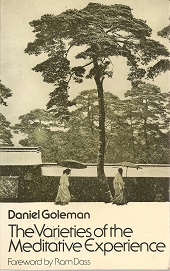The Varieties of the Meditative Experience
 Cover of the first edition | |
| Author | Daniel Goleman |
|---|---|
| Language | English |
| Publisher | Tarcher/G. P. Putnam |
Publication date | 1977/1988 |
| Media type | |
| Pages | 214 |
| ISBN | 0-87477-833-6 |
The Varieties of the Meditative Experienceis a 1977 book by American psychologistDaniel Goleman.It was republished under the titleThe Meditative Mindin 1988.

Synopsis
[edit]Visuddhimagga
[edit]Goleman begins with an outline of theVisuddhimaggaofTheravadanBuddhism.
Survey
[edit]Goleman continues with a survey of eleven[1]types ofmeditationincludingHinduism,Judaism,Christianity,Sufism,Transcendental Meditation,Patanjali'sAshtanga Yoga,IndianTantraandKundalini Yoga,Tibetan Buddhism,Zen,the teachings ofGurdjieffas expressed byP. D. Ouspensky,and the teachings ofJiddu Krishnamurti.
Unity
[edit]Goleman then draws some parallels between various methods, saying that they all share the goal of changing the practitioner's state of consciousness. Each method may have a different word for the "awakened state": sahajsamadhi,Devekut,purity of heart, baqa,jivamukti,cosmic consciousness,turiyatita,siddha,bodhisattva,mujodo no taigeu, objective consciousness,choiceless awareness,arahantship.[2]All of them result inone, single pointof concentration. All except Krishnamurti propose an explicit doctrine that the student is expected to assimilate.[3]
Abhidhamma model
[edit]Next the author reviews Theravadan Buddhism'sAbhidhammawhich describes, in 53 categories (and in other schools of Buddhism up to 175 categories),[4]how wholesome states of mind replace and cancel out unwholesome ones.[5]Which traits are wholesome was distilled empirically from a survey of a large number of early Buddhists who were asked whether each trait facilitated or detracted from their meditation efforts.[6]Goleman writes, "Each of the unhealthy factors is opposed by a healthy factor."[7]
Eastern and Western psychology
[edit]This becomes a basis for contrast betweenEasternandWesternpsychology. According to Goleman, Westerners studypsychopathology,[8]and the English language lacks the words needed to indicate nuances in consciousness.[9]
Goleman searches through modern Western psychology and findsSigmund Freudfailed to ever read and study Eastern texts, and thatbehavioristJohn B. Watsonbemoaned what he saw as the substitution of consciousness for soul.[10]Goleman writes, "For the most part, Western psychologists have been reactive against Eastern psychologies".[11]More in tune are parts ofGordon Allport,Erik Erikson,Ernest Becker,andFranz Alexander.[12]
Goleman finds parallels with Eastern psychologies inPlotinusand in Christian psychology in the writings ofAnthony the Great,St. John of the CrossandMeister Eckhart.[13]He finds a sympathetic ear inWilliam James,Carl Jung,Abraham Maslow,Andras Angyal,Medard Boss,Martin Buber,Erich Fromm,and inAlan Watts,Anthony Sutich,Charles Tartand in contemporary works byKen Wilber,Jack Engler, Daniel P. Brown, andMark Epstein.[14]
Conclusion
[edit]Goleman quickly covers contemporary research on meditation and also research onrelaxation.[15]He ends with a discussion of "how to meditate".[16]
Reaction
[edit]Publishers Weeklywrote about the 1977 book:
To a casual reader, Goleman's study is too full of arcane words and multilingual jargon about states of enlightenment. But to a serious student of meditation, this book, like its predecessor, is an excellent resource.[17]
AppleiTunessays the 1988 book is "a comprehensive and easily accessed overview".[18]
References
[edit]Goleman, Daniel (1988).The Meditative Mind: The Varieties of Meditative Experience.Tarcher.ISBN978-0-87477-833-5.
Notes
[edit]- ^"The Varieties of the Meditative Experience".Kirkus Reviews.RetrievedJuly 14,2012.
- ^Goleman, pp. 112–113.
- ^Goleman, p. 104.
- ^Goleman, p. 119.
- ^Goleman, p. 134.
- ^Goleman, p. 121.
- ^Goleman, p. 123.
- ^Goleman, p. 143.
- ^Goleman, p. 144.
- ^Goleman, pp. 140, 146, 148.
- ^Goleman, p. 146.
- ^Goleman, p. 147–148.
- ^Goleman, pp. 150, 151.
- ^Goleman, pp. 156–162.
- ^Goleman, pp. 162–184.
- ^Goleman, pp. 185–189.
- ^"Publishers Weekly and Library Journal".National Library Board Singapore. Archived fromthe originalon April 18, 2013.RetrievedJuly 15,2012.
- ^"iTunes Preview: The Meditative Mind".Apple.RetrievedJuly 14,2012.
